

Uyseʔ. © 2010 by Mark Rosenfelder · zompist.com Phonology — Consonants —Vowels —Phonotactics —Stress Overall structure Pronouns — Personal pronouns — Demonstratives — Quantifiers and numerals Nouns —Nouns and noun-verbs —Plurals —Compounds —NP order Verbs — Basic sentence order —Passive by omission —Negation —Aspectual particles —Modal particles —Imperatives Adjectives Some transformations — Questions —Doubled verbs —Ongoing action —Locative verbs —Locatives modifying nouns Complex sentences — Subordination —Verbs of saying and thinking —Causatives —Conjunctions —Comparatives —Superlatives Pragmatic particles The calendar — The day —The year Sample texts — Conversation —A poem —The care of Powers —The quotable Nyekhen Lexicon Writing.
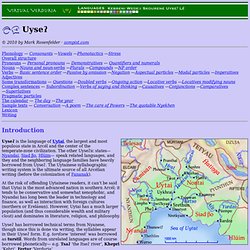
Old Skourene. Lenani-Littoral.
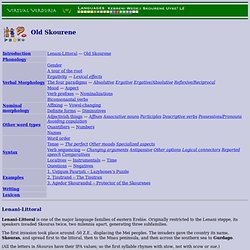
Xurnese grammar. Introduction The language of Xurno Xurnese, called by its speakers Corauši or Xornaurši, is the language of Xurno, the great Southern nation, and the southern anchor of the multilobed cultural unit which is Ereláe.
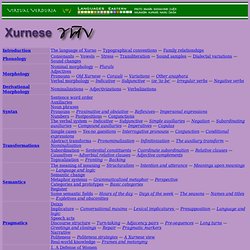
It is spoken as a primary language by over sixty million people, and as an acquired language by many millions more, to say nothing of the influence it has had on other languages in the Axunaic cultural area (known as Xengiman, the Greater Xengi). Xurnese is highly dialectalized; each province has its own distinct dialect, and those of the outlying regions (Xazno, Bolon, Jeor, Gotanel, Idenar) are virtually separate languages. Corauši means ‘Curau speech’, referring to the imperial capital, Curau. As a complication, the present capital is not Curau but Inex. The strength of the standard often leads both the Xurnese and outsiders to accord their language more unity than it really has.
This document describes only standard Corauši Xurnese. Typographical conventions Consonants. Axunashin. As an Eastern language, related to Caďinor and Cuêzi, its overall structure will be familiar to students of Almea, and it isn't as un-Englishlike as Kebreni or Elkarîl.
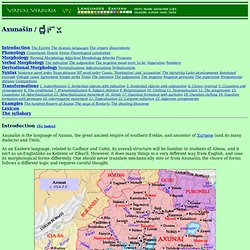
However, it does many things in a very different way from English, and uses its morphological forms differently. One should never translate mechanically into or from Axunašin; the choice of forms follows a different logic and requires careful thought. These latter invaders, who called themselves simply the Ezičimi, the Powerful, conquered an older and more sophisticated civilization, the Wede:i. They were wise enough to leave its technology and cultural institutions alone, merely assuming the top rank in the social structure.
In the early years a Wede:i-based pidgin seems to have developed to allow the conquerors to make themselves understood. Elkarîl. Introduction * History Unusual features Cultural notes Phonology * Phonological constraints Morphology * Prefixes Adjectivizers Nominalizers Attitudinals Anaphora Modifiers Pluralizers Emphasis by length Colors Vowel continua Locatives Numbers Syntax * Word order Case analysis Reductive cases Notes on specific verbs Assignment anaphora Object anaphora Relativization of nouns Subordination within prepositional phrases Subordination of entire sentences Negatives Questions Time The calendar ExamplesLexiconWriting system Introduction [Top] Elkarîl is the language of the elcari of the Elkarin Mountains west of Eretald.
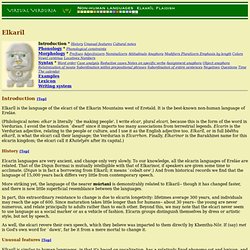
It is the best-known non-human language of Ereláe. (Philological notes: elkar is literally `the making people'. The Kebreni Language. The Monkhayic family of languages, though now restricted to Kebri and the southwestern corner of Dhekhnam, was once spoken throughout the Plain, and indeed has left its linguistic traces heavily on the map of the Plain.

The Mishicama ocean, the Ctelm mountains, the Svetla, Menla, Vesi, Meuna, and Efrat rivers, the nations of Ismahi, Azgami, Koto, Melináe, and Érenat, lake Como, the Arosd delta, and the cities of Kebropol, Lädau, Avéla, Ydamai, Raizumi, Nuveta, Kereta, Mituré, Gödo, Mogör, Melahdo, Trezhda, Mabola, and Pelym all have Monkhayic names. The first states of men in the Plain were Monkhayic: Como and Meṫaiu on the upper Svetla, established about Z.E. -1150. By the time they appeared, men had lived in the Plain for twenty thousand years, and the Monkhayic peoples were divided into dozens of mutually incompatible languages. The Easterners pushed the Monkhayic peoples (those who were not absorbed) north and east (-375). Meṫaiun [To Top] Our sources for Meṫaiun are as follows: The Wede:i Language. This was the first language I put up on the web, soon after writing the Language Construction Kit.
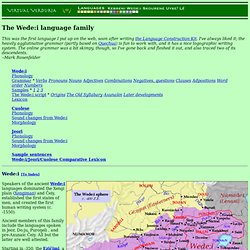
I've always liked it; the heavily agglutinative grammar (partly based on Quechua) is fun to work with, and it has a nice logographic writing system. The online grammar was a bit skimpy, though, so I've gone back and fleshed it out, and also traced two of its descendents. --Mark Rosenfelder Wede:iPhonologyGrammar * Verbs Pronouns Nouns Adjectives Combinations Negatives, questions Clauses Adpositions Word order Numbers Samples * 1 2 3 The Wede:i script * Origins The Old Syllabary Axunašin Later developments Lexicon CuolesePhonologySound changes from Wede:iMorphology JeoriPhonologySound changes from Wede:iMorphology Sample sentencesWede:i/Jeori/Cuolese Comparative Lexicon Wede:i [To Index] Proto-Eastern Philology. Introduction The comparative method Other types of change The speakers of proto-EasternThe proto-Eastern sound system Phonological constraints Proto-Eastern sound changes Cuêzi Caďinor Axunašin Obenzayet Luxajia Morphological classes Verbs Nouns Adjectives Morphology Comparative declension-- Nouns Adjectives Pronouns Comparative conjugation Syntax SampleProto-Eastern LexiconHints for proto-conlangers The Eastern family [To Index] In recent centuries it has become clear that many of the major languages of Ereláe belong to a single family.
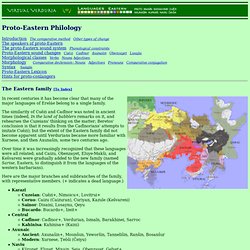
The similarity of Cuêzi and Caďinor was noted in ancient times (indeed, In the land of babblers remarks on it, and rehearses the Cuzeians' thinking on the matter; Beretos' conclusion is that it results from the Caďinorians' attempts to imitate Cuêzi); but the extent of the Eastern family did not become apparent until Verdurians became more familiar with Xurnese, and then Axunašin, some two centuries ago. Proto-Eastern [To Index] Consonants Vowels. Cuêzi grammar. Cuêzi Introduction Sources - Dialects PhonologyOrthography Spelling rules Morphology Nominal declension Masculine - Neuter - Feminine - Unusual endings Adjectival declensions First - Second - Third - Comparatives Pronouns Other pronouns and determiners Verbal morphology Definite - Remote - Imperfect - Passive voice - Causative - Inceptive - Infinitive - Participles - To be - Unusual verbs Derivational morphology Nominalizers - Adjectivizers - Verbalizers - Names Syntax Word order - Case usage Noun phrases Numbers - Comparative expressions - Prepositions Tense usage Infinitive - Tense - Mood - Conditional expressions - Aspect - Passive - Causatives Subordinate clauses - Clitics - Negatives - Questions - ExamplesLexicon To view this page properly you'll need a Unicode font.

Ā ē ī ō ū Ā Ē Ī Ō Ū č ď ř š ť ž Č Ď Ř Š Ť Ž Introduction [To Index] Sources [To Index] Cuêzi was the first language of the Plain to be written, beginning circa -200. Dialects [To Index] Phonology [To Index] to.